Content of the article

Every day, billions of Internet users search Google for the information, services, and products they need. That is why the main task of business owners is to take care of the quality of text and visual content on their website. Visitors, having entered the resource after entering a search query and clicking on the site offered by Google, expect to solve their question as easily and quickly as possible.
The set of factors that are responsible for meeting the needs of users on a web page is called relevance. And the search engine, in turn, promotes sites that contain relevant information, that is, that is most useful, to the top of the page. And resources filled with low-quality content or random information, on the contrary, lower the output, driving users away from such links.
What is relevance
Translated from English, the word “relevance” means “relevance”. The interpretation for the web sphere is the correspondence of the search result to the user’s expectations.
Relevance is how accurate and informative the result of the query entered by the visitor in the search feed is. Google and other search engines promote sites with content that hits the mark.
Let’s consider the concept of relevance level visually.
For example, you are a practicing psychologist who temporarily stopped working due to certain life circumstances. Now there is a need to competently resume practice, convey information about your services, advance the project as quickly and qualitatively as possible. Of course, you need to show yourself to users who need the help of a psychologist right now. In the search bar, write the query: “how to promote the services of a psychologist in Ukraine” and get the result:
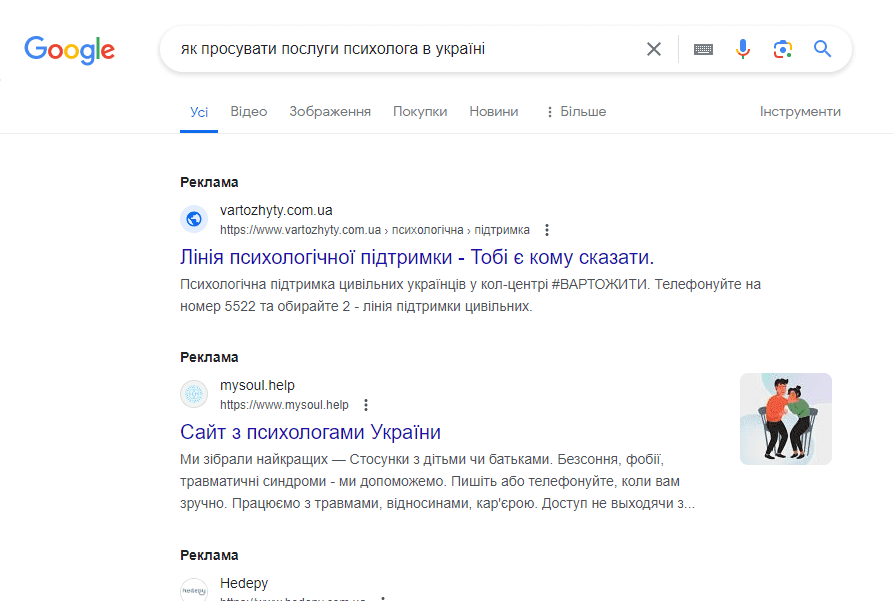
We see that initially Google issues the resources for which it is configured contextual advertising. Algorithms work in such a way that they first show just such sites, and they are competitors in the niche. For us, this is a reason to go to these links and see how competitors position their project. And then we look for information on relevant sites.
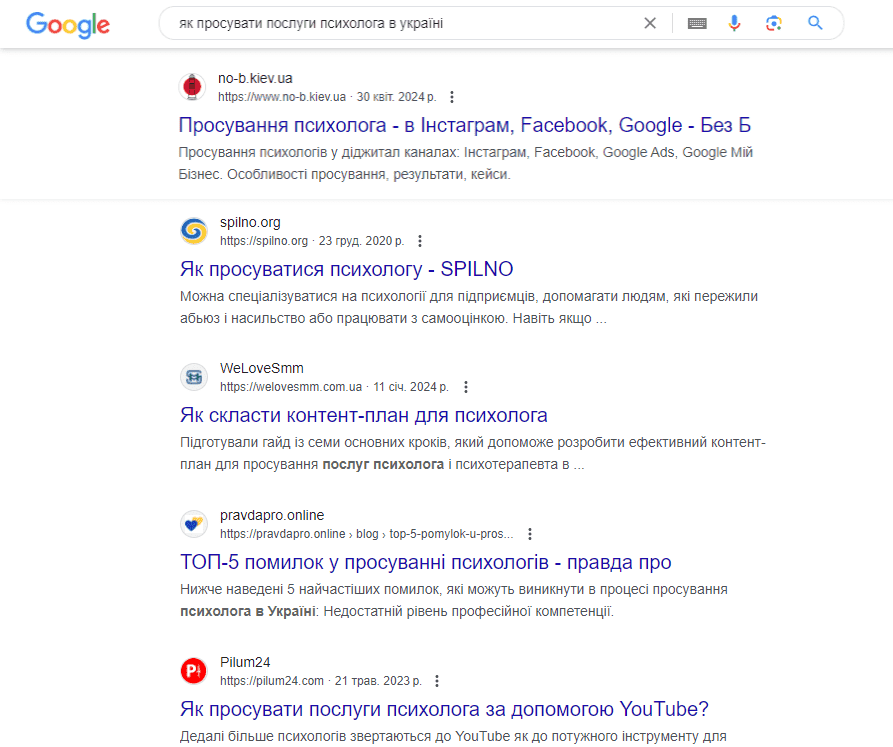
The first resource is Internet advertising agencies. There it is suggested to start with the definition of the target audience according to the specifics of the psychologist’s activity, to use it Google My Business, Google Ads, as well as involve social networks: Facebook and Instagram.
The news portal, which comes in second place, recommends promotion on the social network Instagram with the involvement of targeted advertising and the development of a personal brand. There is also a very brief list of actions that should help convert traffic into subscriptions and sales.
The SMM agency closes the TOP-3 relevant sites. Here is an attractive article that visually and fully reveals the topic, which analyzes the question of how to promote a psychologist through social networks Facebook or Instagram. The information is considered from the point of view of marketing, so the article is as useful as possible and will allow you to take the first steps in promotion correctly.
Next, the search engine offers the articles “TOP-5 mistakes in the promotion of psychologists”, “How to promote the services of a psychologist using YouTube?”, which can also be studied and used. But the following proposed sites – the sale of the services of the agency “SMM for a psychologist” and “Proposal of cooperation for psychologists” raise the question: according to what principle did Google put these articles on the first page? Sometimes algorithms remain mysteries.
In general, you can stop the search on this or collect more information, but using the example of this query, we can see that Google did not list sites that do not meet the query in the TOP-3. It is important to note that the result we get directly depends on the level of relevance of the user’s request. That is, if you ask the search engine the question “how to promote services” instead of “how to promote the services of a psychologist in Ukraine”, the list in output will be different and there will be no guaranteed hit on the target. A narrowly focused search gives better results.
Kinds of relevance
Specialist from SEO promotion constantly analyzes and maintains the relevance of pages on the site. The relevance of queries is evaluated using three main approaches.
- Formal
This approach is the basis for ranking sites by search engines. Its algorithm is built on the basis of artificial intelligence solutions, trained in advance to correctly choose the results. It is according to the idea of AI that an ideal group of resources is formed, which should solve the user’s questions.
- Informative
Relevance evaluates the assessor (English “assessor”), who is an independent evaluator of the site for compliance with the request. Also, this person analyzes the project in general: design, relevance and veracity of the information provided, ease of use of the site, etc. Decisions regarding the quality of resources are made on the basis of in-depth analytics.
- Pertinent
A web resource is evaluated depending on the number of users’ visits to it. With a pertinent approach, the content of the page may be far from ideal, but if the issued result meets the user’s request from the point of view of semantics, then Google will definitely show it in the TOP.
Relevance in search engines
As we mentioned above, ranking of sites depends on the level of relevance of information on them.
If the user receives a complete answer to his question, closes the existing request, then the relevance of the page is higher, and the site gets to the first positions in the output.
For example, in response to the query “how to choose a screwdriver”, the searcher considers “Which screwdriver is the best of all” to be a relevant article? The main questions when choosing.” on the multifunctional product search service. And in second place is the hotline project, which positions itself as an Internet service that “helps the buyer find, compare and decide on the choice of product, store and make a purchase.”
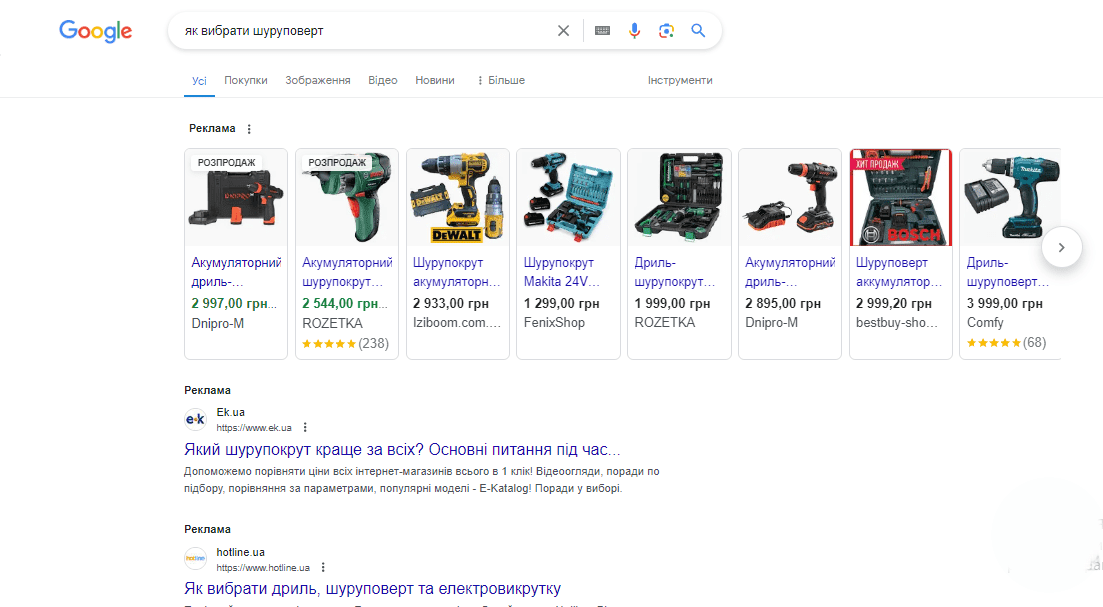
That is, both sites are essentially marketplaces. It says that:
- search the system immediately offers options for screwdrivers and online stores where you can buy them, that is, it takes care of the user;
- the articles correspond to the request and contain useful information that will help to find out the answer to the question and understand which tool is better suited for which purpose;
- saturation of articles with the necessary keywords is optimal.
There is a nuance here. Users can search for goods and services in different ways. For example, someone will search for “children’s scooter” using the same phrase, while others will type “city scooter” or “scooter for a child of 5 years” into Google. Therefore, when working on the relevance of the site, you should pay attention to all possible keywords, using the ones that are promising as much as possible. Keyword planners, such as Google Ads, help to collect keys. You can read more about how to effectively perform a complex search for keywords in another our article.
Regarding the point about the usefulness of the article, it is worth noting that the search engine evaluates the usefulness of information based on user behavior. If the latter stay on the page for a long time, study it, begin to go to other pages of the resource, the relevance of the site is considered high, and it is worth the attention of more visitors.
For some requests, the search engine displays not only articles, but also videos in the TOP. For example, “exercises on the buttocks”.
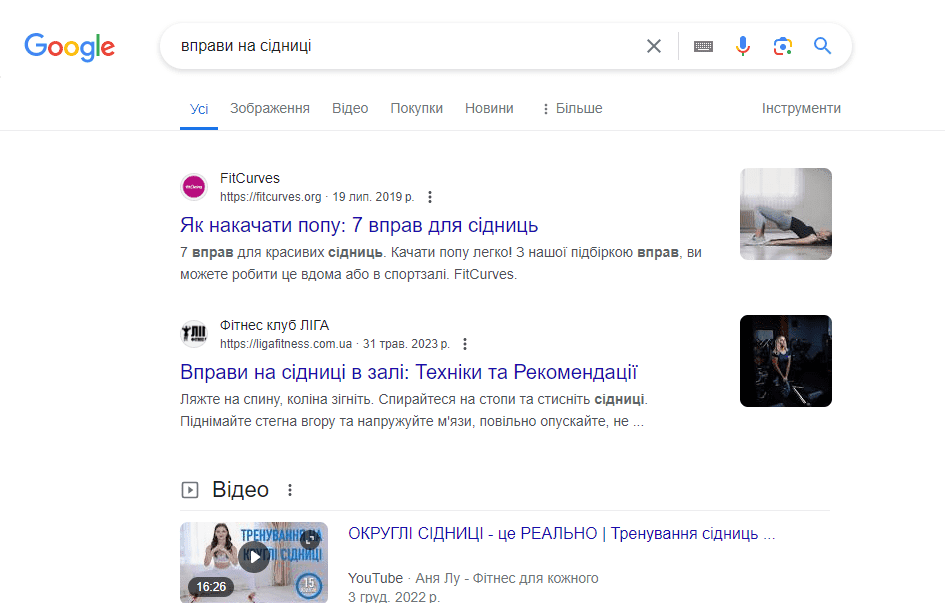
Algorithm worked in such a way that the relevance is greater on the sites of fitness centers, and then several videos are offered. After all, in order to achieve his goal, the user must see how to do it, and not just read.
The main factors affecting the relevance of the site
Special attention should be paid resource usability. No matter how interesting and useful the information is, it is worthless without a clear structure.
The guarantee of successful site relevance is a well-chosen and built strategy by an SEO specialist.
So, there are three important factors that should be paid attention to during the promotion of the project.
- Internal
A technically correct site has:
- meta tags;
- keywords (take into account the number, density, distribution by articles);
- a logically understandable structure;
- optimal amount of text on a web page;
- working links, easy to upload photos and videos;
- pages, which load quickly;
- clear URL.
All this affects the position of the resource in the issue.
- External
The memorability of the resource is of great importance. The search engine understands – if others are talking about you, then the site is worth paying attention to. And the more often the link to the web resource appears in blogs or public sites related to the topic, the better. But be aware that mentions on questionable pages with technical issues or content will lower your site’s value to search engines.
- Behavioral
Relevance will be high if the indicators conversions stable or growing. The traffic to the site is high-quality, and not just a large flow of visitors, that is, users come and spend a lot of time on the resource, perform targeted actions, and after a while return to you again. The activity of visitors indicates a good quality of information filling and navigation within the resource.
Relevance criteria
There are many criteria for ranking pages, and only Google knows the exact list. But the main ones are divided into 2 groups: internal and external.
Internal are:
- Having enough keywords. They help promote the site organically, because these words are the key queries that users enter into the search engine.
- The volume of the text should be such as to fully reveal the topic and provide answers to all possible questions.
- The article will be easy to understand if it includes subheadings, short paragraphs, numbered and bulleted lists of important nuances.
- Internal links from one page to another, called internal linking. If they are present on the site and are also keywords, the search engine perceives this as an additional marker of the level of relevance.
- Technical serviceability of the site: high download speed, lack of 404 pages and others.
- The content on the web resource should be relevant and unique, updated frequently.
- The behavioral factor we talked about a little above: active user actions, high conversion.
External ones are:
- Having a large number of links and recommendations from external resources to yours.
- High quality and authority of donor sites from which users are transferred.
- The related topic of the website from which the traffic comes to you also plays a role in increasing the relevance and weight of the resource.
How is site relevance calculated?
Algorithms Google evaluates the relevance of keywords on a web resource. However, this complex system of rules and calculations for determining the ranking of pages is not exactly known, both for users and for SEO specialists. It is only possible to rely on the criteria and factors described above and thus analyze the results of the work of search engines.
Relevant the assessment varies depending on the context and profile of potential customers. If earlier relevance was measured by counting the density of key queries in articles and titles, now a clear formula has appeared.

where R is the relevance of the keyword (the query entered by the user in the search bar);
PR – general rank or rating of the web resource, which depends on the request;
T – textual relevance, i.e., compliance with the internal criteria of page relevance;
L – link of relevance or correspondence of the text with the link to the site to the search query.
You can understand what level of relevance a site has in numerical terms with the help of special services.
How to check the relevance of a page?
There are two methods of analyzing the pages on your site: manually or with the help of services. Let’s analyze both with examples.
- To conduct analytics manually, we enter keywords into the Google search bar and see what comes up. The following combination must be specified: key query + site: URL
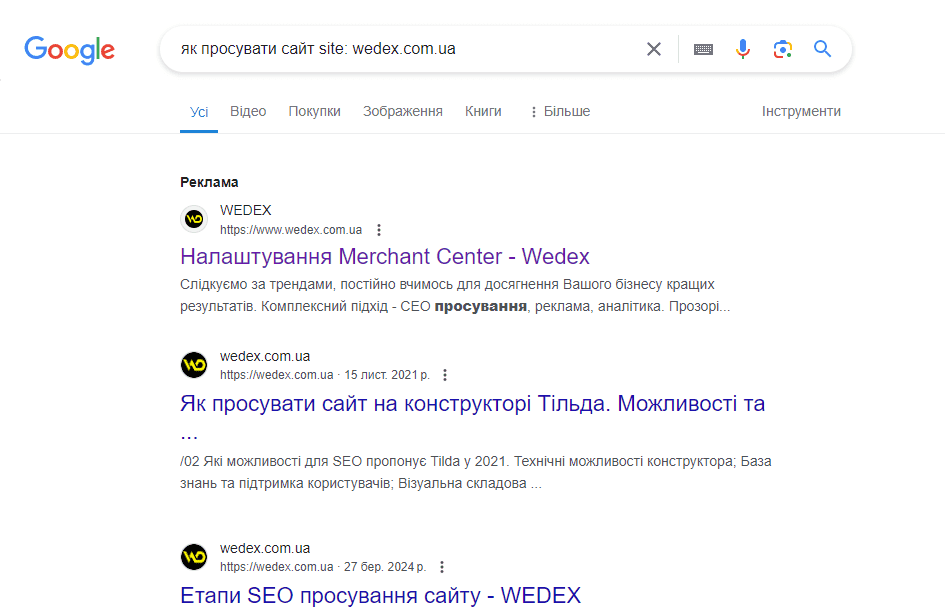
- There are many services for checking the index of the level of relevance of a site or individual pages. For example, popular Serpstat. For text analytics, it is suggested to perform a number of actions:
- group key phrases using “clustering”;
- select all clusters or manually mark those to be analyzed and start “text analytics” using the “open text analytics” button.
The analysis takes into account the URL of the target page, the list of keywords from the cluster for which the page is optimized, and as a bonus – SEO analysis of competitors’ articles that are in the TOP-15 in the search engine. After such a detailed analysis, it is immediately clear where and what exactly needs to be improved on the pages of the web resource.
You can use any other service to your taste, or, if there are doubts about the results, use several sources at once and compare their results.
Ways to increase the relevance of pages
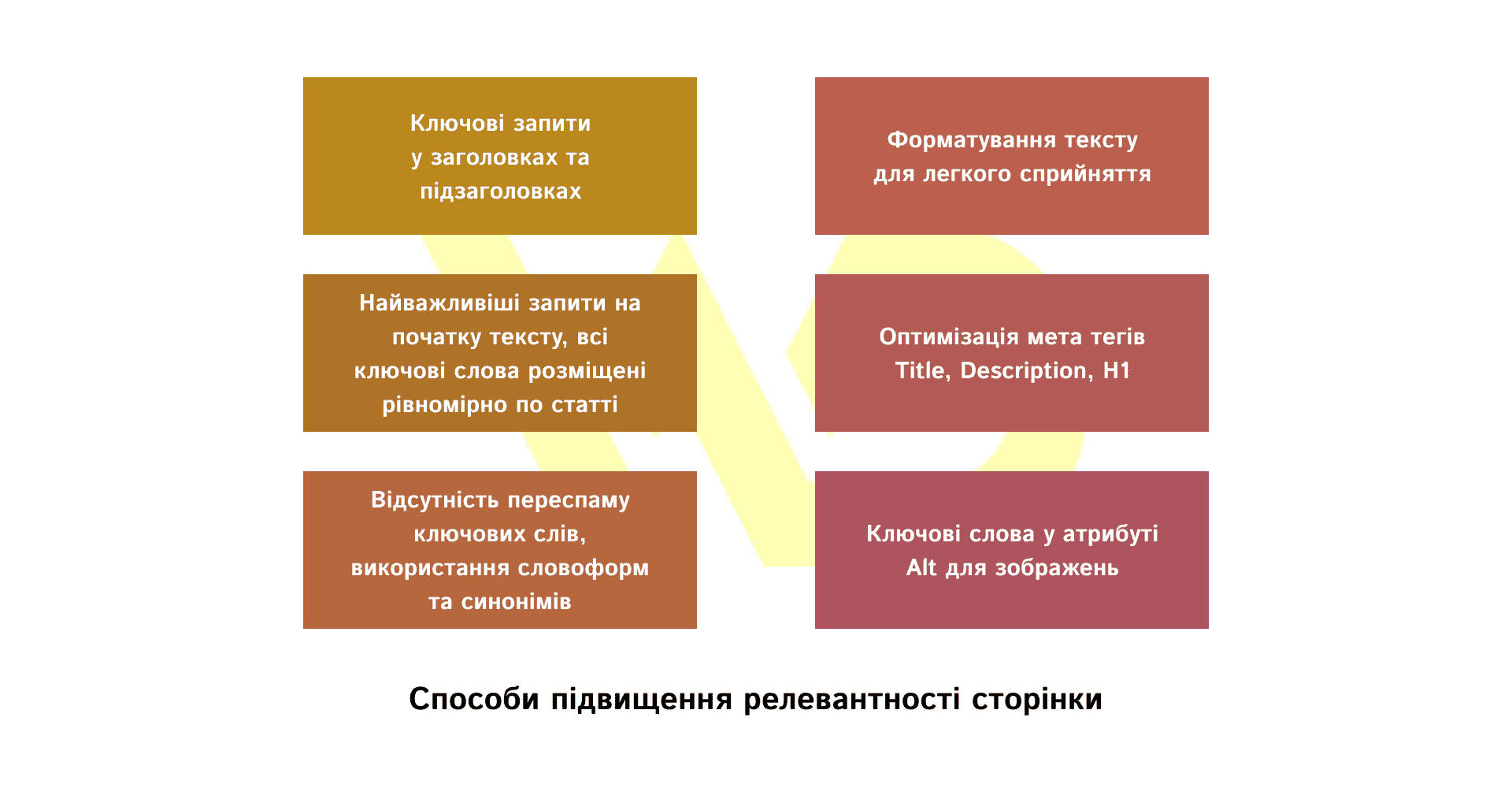
To make all the pages of your website more relevant, do the following:
- Pay special attention to headings and subheadings. It is desirable that the keywords are in each – from H1 to H6, if the article needs it. As a rule, it is enough to do H1-H4, but remember that these elements are more significant on the page than the article. In addition to increasing the relevance of the page, queries in the headers also make navigation easier for users.
- Competently place the keys in the text. Search robot, like users, examines pages from top to bottom, so the most important queries should be placed in the first or second paragraph of the article. However, it should be done organically so that the article does not become a canvas of key phrases. The distribution of all existing queries should be more even, because the search engine will not like their clustering in one place.
- Too many keywords, or spam, will have a bad effect on relevancy. The approximate number of requests per 1000 characters of the article is 1-3. Let’s use word forms and synonyms to create really high-quality text for both robots and humans.
- Format the text so that it is easy to understand: make small paragraphs, add lists, links with relevant anchors to significant pages within the site.
- Optimize the meta tags Title, Description, H1 so that the search engine can evaluate the relevance of the page to the search query.
- Add keywords to the Alt attribute of images. This is a text description of the images that helps to increase their relevance, rank them in the results for users when searching for “Images” and displays a text description of the images or photos if for some reason they did not load.
To summarize
In conclusion, remember – to ensure the relevance of your web resource, pay attention to the current algorithms of search engines, the quality, relevance and interest of the content you publish.
A resource is truly valuable when its owner knows the intentions of users and closes all incoming requests.
Using the knowledge from the article and understanding what relevance is and how to constantly increase it will allow you to bring your project to the TOP, get more quality traffic and profit.






 15/05/2024
15/05/2024  3937
3937



